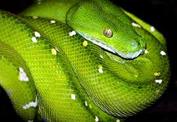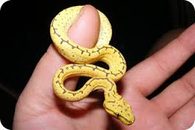Green Tree Python Care (Morelia viridis)
Erica Mede, CVT
Natural History
The Green tree python is a beautiful, eye catching snake from New Guinea, the islands of Indonesia, and the Cape York peninsula in Australia in the lush rainforests. These snakes are frequently confused with Emerald tree boas which are native to South America. Green trees are a relatively slim bodied snake with a large head and long tail well suited for their arboreal life style. Depending on the region and the gender (females are larger typically) these beautiful snakes can reach 5-7 feet and live 15-20 years.
The babies are often a red to yellow color and will change color and pattern as they mature which takes around 3 years. Although these snakes are stunning they are more of an ornamental species for most reptile keepers. Depending on the origin of the blood line, this species is labeled as “Sorong”, “Biak”, “Merauke”, and “Aru” although most casual keepers refer to them simply as Green trees.
The Green tree python is a beautiful, eye catching snake from New Guinea, the islands of Indonesia, and the Cape York peninsula in Australia in the lush rainforests. These snakes are frequently confused with Emerald tree boas which are native to South America. Green trees are a relatively slim bodied snake with a large head and long tail well suited for their arboreal life style. Depending on the region and the gender (females are larger typically) these beautiful snakes can reach 5-7 feet and live 15-20 years.
The babies are often a red to yellow color and will change color and pattern as they mature which takes around 3 years. Although these snakes are stunning they are more of an ornamental species for most reptile keepers. Depending on the origin of the blood line, this species is labeled as “Sorong”, “Biak”, “Merauke”, and “Aru” although most casual keepers refer to them simply as Green trees.

Enclosure
The enclosure for Green tree pythons should be completely arboreal, these snakes even eat with their heads hanging down from the branches! Most of their time will be spent curled up on branches or draped down during the night when the snake is most likely to be active. Aquariums can be utilized but a custom enclosure or enclosure specially created for arboreal use is highly recommended.
A 20-30 gallon aquarium can be used for young snakes but larger enclosures are preferred especially with the focus primarily on vertical spacing. A partial or full screen enclosure is an excellent habitat although keeping high humidity is difficult and requires diligence and some creative solutions. The draw to a partial or full screen cage is the ventilation although a ceiling fan or small computer fan can be rigged to keep the air circulating as long as the humidity is monitored closely. Boaphile makes excellent arboreal caging systems that can be modified and customized. There are other excellent arboreal enclosure systems that are readily available as well. Any custom cage created should be waterproof and well ventilated! Adults will typically need a 3' x 2' x 2' enclosure to accommodate their nocturnal hunting habits.
The enclosure for Green tree pythons should be completely arboreal, these snakes even eat with their heads hanging down from the branches! Most of their time will be spent curled up on branches or draped down during the night when the snake is most likely to be active. Aquariums can be utilized but a custom enclosure or enclosure specially created for arboreal use is highly recommended.
A 20-30 gallon aquarium can be used for young snakes but larger enclosures are preferred especially with the focus primarily on vertical spacing. A partial or full screen enclosure is an excellent habitat although keeping high humidity is difficult and requires diligence and some creative solutions. The draw to a partial or full screen cage is the ventilation although a ceiling fan or small computer fan can be rigged to keep the air circulating as long as the humidity is monitored closely. Boaphile makes excellent arboreal caging systems that can be modified and customized. There are other excellent arboreal enclosure systems that are readily available as well. Any custom cage created should be waterproof and well ventilated! Adults will typically need a 3' x 2' x 2' enclosure to accommodate their nocturnal hunting habits.

Lighting
This species is primarily nocturnal but still benefit from the use of UVB bulbs during the day light portion of their light cycle. Ultraviolet B radiation is not necessarily required for calcium absorption in snakes as they are able to use the calcium from their whole prey however, the UVB lights still offer health and psychological benefits. A 5.0 ReptiSun bulb is an excellent addition to any enclosure, especially for growing hatchlings, wild caught individuals, and pregnant females.
This species is primarily nocturnal but still benefit from the use of UVB bulbs during the day light portion of their light cycle. Ultraviolet B radiation is not necessarily required for calcium absorption in snakes as they are able to use the calcium from their whole prey however, the UVB lights still offer health and psychological benefits. A 5.0 ReptiSun bulb is an excellent addition to any enclosure, especially for growing hatchlings, wild caught individuals, and pregnant females.

Temperature
The ambient (air) temperature should be kept around 84-88°F with the basking spot at no higher than 92°F as this species suffers from heat stress. Higher temperatures can cause regurgitation especially in wild caught individuals. Temperatures at night can go as low as 75°F without ill effects. The temperature in the cage should be controlled with a thermostat and monitored with two different thermometers, preferably three. One thermometer should be placed at the height of the basking spot, one midway in the cage, and another preferably on the floor of the cage. Under tank heaters, heat cable (used on the outside of the cage only!), heat tape, and heat bulbs can all be utilized for heating the enclosures. Heat panels are another wonderful way to heat a large enclosure although these can be expensive. Ceramic heat emitters can also be used especially at night as they do not emit any light to throw off the light cycle of the animal.
The ambient (air) temperature should be kept around 84-88°F with the basking spot at no higher than 92°F as this species suffers from heat stress. Higher temperatures can cause regurgitation especially in wild caught individuals. Temperatures at night can go as low as 75°F without ill effects. The temperature in the cage should be controlled with a thermostat and monitored with two different thermometers, preferably three. One thermometer should be placed at the height of the basking spot, one midway in the cage, and another preferably on the floor of the cage. Under tank heaters, heat cable (used on the outside of the cage only!), heat tape, and heat bulbs can all be utilized for heating the enclosures. Heat panels are another wonderful way to heat a large enclosure although these can be expensive. Ceramic heat emitters can also be used especially at night as they do not emit any light to throw off the light cycle of the animal.

Humidity
The humidity in the cage is vitally important and needs remain between 50 and 70% to mimic their natural habitat. The humidity, depending on the cage size, can be maintained using live vegetation, mister systems, fogger systems, large water dishes, or room humidifiers. Spraying the cage can be utilized for small enclosures as well. Hygrometers must be used to monitor humidity levels.
The humidity in the cage is vitally important and needs remain between 50 and 70% to mimic their natural habitat. The humidity, depending on the cage size, can be maintained using live vegetation, mister systems, fogger systems, large water dishes, or room humidifiers. Spraying the cage can be utilized for small enclosures as well. Hygrometers must be used to monitor humidity levels.

Substrate
With such a high level of humidity in the enclosure, it is important to monitor and change the substrate frequently to prevent mold. Some owners keep their pets in natural vivariums with live plants and natural drainage systems. These enclosures do require some degree of diligence and maintenance. Newspaper replaced daily or reptile carpet can be used as it does not mold quickly. Wood shavings (not cedar or pine) such as orchid bark can be utilized but must be agitated daily and changed weekly.
Accessories
Caging accessories should include heavy vegetation to provide some hide areas, especially for young snakes. Vertically inclined branches should be offered for enrichment and exercise but a few branches should be completely horizontal and thick enough for the snake to drape over them and be supported. Branches or perches can be natural wood or PVC piping. Other creative versions of perches have been created such as wrapping fake vines over PVC piping. Waterfalls can be added to the enclosure as well as other decorations.
With such a high level of humidity in the enclosure, it is important to monitor and change the substrate frequently to prevent mold. Some owners keep their pets in natural vivariums with live plants and natural drainage systems. These enclosures do require some degree of diligence and maintenance. Newspaper replaced daily or reptile carpet can be used as it does not mold quickly. Wood shavings (not cedar or pine) such as orchid bark can be utilized but must be agitated daily and changed weekly.
Accessories
Caging accessories should include heavy vegetation to provide some hide areas, especially for young snakes. Vertically inclined branches should be offered for enrichment and exercise but a few branches should be completely horizontal and thick enough for the snake to drape over them and be supported. Branches or perches can be natural wood or PVC piping. Other creative versions of perches have been created such as wrapping fake vines over PVC piping. Waterfalls can be added to the enclosure as well as other decorations.

Feeding
This species is a slow growing species but they are aggressive hunters! This species does have a problem with regurgitation in high temperatures. Also, most Green tree pythons will not defecate after every meal but after every second or third meal. In the wild, these snakes consume small mammals, small birds, lizards, and frogs. However, in captivity, most are offered mice, rats, and pheasant chicks. All prey is recommended to be pre-killed as live prey can cause severe injuries to snakes. Frozen prey that has been properly thawed is highly recommended by Chicago Exotics. Ideally, hatchlings and juveniles should be fed every 7-10 days while adults are fed roughly every two weeks.
This species is a slow growing species but they are aggressive hunters! This species does have a problem with regurgitation in high temperatures. Also, most Green tree pythons will not defecate after every meal but after every second or third meal. In the wild, these snakes consume small mammals, small birds, lizards, and frogs. However, in captivity, most are offered mice, rats, and pheasant chicks. All prey is recommended to be pre-killed as live prey can cause severe injuries to snakes. Frozen prey that has been properly thawed is highly recommended by Chicago Exotics. Ideally, hatchlings and juveniles should be fed every 7-10 days while adults are fed roughly every two weeks.
If you have any questions, please feel free to call us at 847-329-8709.

